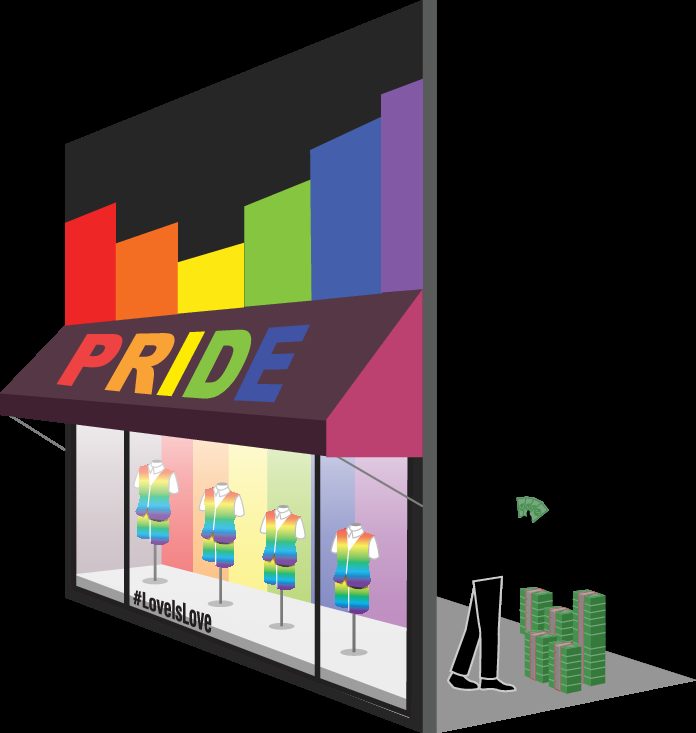Hundreds of companies release their collections every year. A facade of support that covers for companies that don’t actually want change. Walmart’s “pride & joy” section on their website means nothing when they continue to donate upwards of $442,000 to 121 politicians who push anti-gay legislation.
Many companies will show their support by releasing pride collections or changing their logos rainbow for the month. Then, on July 1 at midnight, all the logos change back to standard and the pride collections hit the clearance rack. Another pride month has gone by and no awareness has been raised for the people who this actually affects.
“Well, I think we must understand that it’s a gesture of support, but gestures of support, nice words, visible images of solidarity aren’t always enough,” said gender and sexuality professor Karen Tongson at University of Southern California in an interview with PBS News Hour. “They’re often never enough, actually.”
Historically, companies with discriminatory policies in place rush to join the pride parade, but still refuse to change their own policies. PayPal, for example, changed its logo rainbow in support for pride, but won’t allow transgender users to change their account from their birth name.
Other awareness months aren’t nearly as capitalized off of. Pride month is much easier to package and slap a price on. The LGBTQ+ community has countless stereotypes that are easy to market, especially for a retail store. People see LGBTQ+ as flamboyant and fashion lovers— combine these and that’s an easy fashion line to market. Other months, however, are much trickier to market. Bath & Body works in late January 2022 released a Black History Month collection which featured extremely stereotypical designs, patterns, scents, and colors. The collection immediately faced backlash from Black voices calling out the collection. So why do people accept LGBTQ+ stereotypes? These caricatures are seen as harmless and that’s where the harm lies; flamboyant fashionistas don’t upset or offend people, and LGBTQ+ voices are silenced to a point of ignoring these stereotyping with the goal of profit.
“I think sometimes it’s saturated the market so much that what is supposed to be a celebration and an opportunity to learn and bring awareness becomes more of a fashion statement,” said middle school civics teacher Tatiana Mckinney. “But I think once it became an issue, especially for me, it was during the pride moments where there were rainbows everywhere, and people weren’t really aware of what each of the symbols meant, or why different groups use different things.”
Pride products aren’t entirely bad. For one thing, it’s nice to have people in the LGBTQ+ community feel recognized and for allies to show their support more openly. But this is a rainbow without the rain. People in the LGBTQ+ community have been scrutinized and hurt for decades and continue to be. Strides are made, but oftentimes, these aren’t enough. Systems and charities have been put in place to help people in the community and raise awareness, but if no one knows about these foundations, they can’t get funding, and can’t help anyone.
Companies that choose to release pride collections or even simply change their logo in support should be doing something to aid in change. Some of the profits from these collections should go to foundations like the Trevor Project. Oftentimes without proper research, companies that do donate end up donating to actively homophobic foundations. Disney has recently been under fire for funding supporters of the “Don’t Say Gay” bill; Disney tried to balance this support by attempting to donate to the Human Rights Campaign where their donation was rejected. Their attempted donation was a blatant cover-up for their backing of the “Don’t Say Gay” bill— a bill that many feel discriminates against LGBTQ+ people and sets a precedent to avoid discussing anything beyond heterosexuality.
The Trevor Project is a charity and research foundation aiding in suicide prevention within the LGBTQ+ community. Many LGBTQ+ youth feel a sense of wrongdoing when they realize their sexual orientation isn’t heterosexual, because society has set a standard of heterosexuality being “normal.” A majority doesn’t make something “normal”: it just makes it the majority.
Because of this, suicide rates in the community are extremely high due to feelings of alienation, feelings of wrongdoing, and bullying/mistreatment. According to the statistics made available by the Trevor Project, 1.8 million LGBTQ+ youth, aging 13-24, seriously consider suicide. It is estimated by the Trevor Project that at least one of these youth attempts every 45 seconds. Along with suicide contemplation and attempts, LGBTQ+ youth often use substances to cope; 47% of LGBTQ+ youth under 21 have used alcohol in the last year according to a 2021 study by the Trevor Project. Alcohol isn’t the only substance that was reported; 11% of youth under 21 have reported using prescription drugs that weren’t prescribed to them. These youth are at risk because of the lack of real support. Companies simply changing their color scheme won’t solve these issues or make them go away.
“There has to be a point where there’s a message and intent behind what you’re actually trying to do,” said Mckinney.
If companies would place information around these collections, whether it be signs, posters, or even on the tags, more people who wish to support the LGBTQ+ community could do so through a new awareness. As beautiful as seeing the rainbow on so many people is, it doesn’t actually do anything to save LGBTQ+ people from harm, scrutiny, mistreatment, alienation, or feelings of wrongdoing. Real awareness requires real change.










